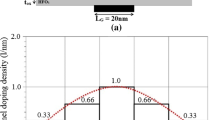Abstract
A vertical carbon nanotube field-effect transistor (CNTFET) based on silicon (Si) substrate has been proposed and simulated using a semi-classical theory. A single-walled carbon nanotube (SWNT) and an n-type Si nanowire in series construct the channel of the transistor. The CNTFET presents ambipolar characteristics at positive drain voltage (Vd) and n-type characteristics at negative Vd. The current is significantly influenced by the doping level of n-Si and the SWNT band gap. The n-branch current of the ambipolar characteristics increases with increasing doping level of the n-Si while the p-branch current decreases. The SWNT band gap has the same influence on the p-branch current at a positive Vd and n-type characteristics at negative Vd. The lower the SWNT band gap, the higher the current. However, it has no impact on the n-branch current in the ambipolar characteristics. Thick oxide is found to significantly degrade the current and the subthreshold slope of the CNTFETs.
Article PDF
Similar content being viewed by others
Avoid common mistakes on your manuscript.
References
R. H. Dennard, F. H. Gaensslen, H.-N. Yu, V. L. Rideout, E. Bassous and A. R. LeBlance, “Design of ion-implanted MOSFET’s with very small physical dimensions”, IEEE J. Solid-State Circuits 9(5), 256–268 (1974). http://dx.doi.org/10.1109/JSSC.1974.1050511
M. Ieong, B. Doris, J. kedzierski, K. Rim and M. Yang, “Silicon device scaling to the sub-10-nm regime”, Science 306(5704), 2057–2060 (2004). http://dx.doi.org/10.1126/science.1100731
Ph. Avouris, “Carbon nanotube electronics and photonics”, Phys. Today 62(1), 34–40 (2009). http://dx.doi.org/10.1063/1.3074261
Min Zhang, “Improving the Electrical Contact Property of Single-Walled Carbon Nanotube Ar-rays by Electrodeposition”, Nano-Micro Lett. 5(4), 242–246 (2013). http://dx.doi.org/10.5101/nml.v5i4.p242-246
Q. Cao and S.-J. Han, “Single-walled carbon nanotubes for high-performance electronics”, Nanoscale 5(19), 8852–8863 (2013). http://dx.doi.org/10.1039/c3nr02966b
A. D. Franklin, M. Luisier, S.-J. Han, G. Tulevski, C. M. Breslin, L. Gignac, M. S. Lundstrom and W. Haensch, “Sub-10 nm carbon nanotube transistor”, Nano Lett. 12(2), 758–762 (2012). http://dx.doi.org/10.1021/nl203701g
F. Kreupl, “Carbon nanotubes finally deliver”, Nature 484, 321-322 (2012). http://dx.doi.org/10.1038/484321a
J. Li, C. Zhao, Q. Wang, Q. Zhang, Z. Wang, X. Zhang, A. I. Abutaha and H. N. Alshareef, “Vertically aligned carbon nanotube field-effect transistors”, Carbon 50(12), 4628–4632 (2012). http://dx.doi.org/10.1016/j.carbon.2012.05.049
J. Li, Q. Wang, W. Yue, Z. Guo, L. Li, C. Zhao, X. Wang, A. I. Abutaha, H. N. Alshareef, Y. Zhang and X. Zhang, “Integrating carbon nanotubes to Si by means of vertical carbon nanotube field-effect transistors”, Nanoscale, accept. http://dx.doi.org/10.1039/C4NR00978A
J. Mores, “Turning the world vertical: MOSFETs with current flow perpendicular to the wafer surface”, Appl. Phys. A 87(3), 531–537 (2007). http://dx.doi.org/10.1007/s00339-007-3986-9
N. Rouhi, D. Jain, K. Zand and P. J. Burke, “Fundamental limits on the mobility of nanotube-based semiconducting inks”, Adv. Mater. 23(1), 94–99 (2011). http://dx.doi.org/10.1002/adma.201003281
M. Engel, J. P. Small, M. Steiner, M. Freitag, A. A. Green, M. C. Hersam and Ph. Avouris, “Thin film nanotube transistors based on self-assembled, aligned, semiconducting carbon nanotube arrays”, ACS Nano 2(12), 2445–2452 (2008). http://dx.doi.org/10.1021/nn800708w
S. Heinze, M. Radosavljevic, J. Tersoff and Ph. Avouris, “Unexpected scaling of the performance of carbon nanotube Schottky-barrier transistors”, Phys. Rev. B 68, 235418 (2003). http://dx.doi.org/10.1103/PhysRevB.68.235418
S. Heinze, J. Tersoff and Ph. Avouris, “Electrostatic engineering of nanotube transistors for improved performance”, Appl. Phys. Lett. 83(24), 5038–5040 (2003). http://dx.doi.org/10.1063/1.1632531
J. Li, Q. Zhang and M. B. Chan-Park, “Simulation of carbon nanotube based p-n junction diodes”, Carbon 44(14), 3087–3090 (2006). http://dx.doi.org/10.1016/j.carbon.2006.04.041
J. Li, Y. C. Cheng, Z. B. Guo, Z. H. Wang, Z. Y. Zhu, Q. Zhang, M. B. Chan-Park, U. Schwingenschlögl and X. X. Zhang, “Influence of contact height on the performance of vertically aligned carbon nanotube field-effect transistors”, Nanoscale 5(6), 2476–2481 (2013). http://dx.doi.org/10.1039/c3nr33263b
W. Zhang, C. Chen and Y. Zhang, “Modeling of carbon nanotube field-effect transistor with nanowelding treatment”, Microelectron. J. 40(12), 1681–1685 (2009). http://dx.doi.org/10.1016/j.mejo.2009.08.002
S. Heinze, J. Tersoff, R. Martel, V. Derycke, J. Appenzeller and Ph. Avouris, “Carbon nanotubes as Schottky barrier transistors”, Phys. Rev. Lett. 89, 106801 (2002). http://dx.doi.org/10.1103/PhysRevLett.89.106801
A. Javey, J. Guo, Q. Wang, M. Lundstrom and H. Dai, “Ballistic carbon nanotube field-effect transistors”, Nature 424(7), 654–657 (2003). http://dx.doi.org/10.1038/nature01797
Author information
Authors and Affiliations
Corresponding authors
Rights and permissions
Open Access This article is licensed under a Creative Commons Attribution 4.0 International License, which permits use, sharing, adaptation, distribution and reproduction in any medium or format, as long as you give appropriate credit to the original author(s) and the source, provide a link to the Creative Commons licence, and indicate if changes were made.
The images or other third party material in this article are included in the article’s Creative Commons licence, unless indicated otherwise in a credit line to the material. If material is not included in the article’s Creative Commons licence and your intended use is not permitted by statutory regulation or exceeds the permitted use, you will need to obtain permission directly from the copyright holder.
To view a copy of this licence, visit https://creativecommons.org/licenses/by/4.0/.
About this article
Cite this article
Li, J., Yue, W., Guo, Z. et al. Unique Characteristics of Vertical Carbon Nanotube Field-effect Transistors on Silicon. Nano-Micro Lett. 6, 287–292 (2014). https://doi.org/10.1007/BF03353793
Received:
Accepted:
Published:
Issue Date:
DOI: https://doi.org/10.1007/BF03353793




